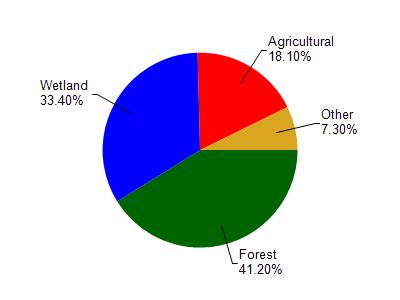Langlade
No
No
Yes
Fish and Aquatic Life
Overview
Deep Wood Lake is a very soft water drainage lake having acid, clear water of moderate transparency. The entire lake is surrounded by upland covered with hardwoods and some conifer. The littoral materials are composed of sand (60%), muck (20%), gravel (15%), and rubble (5%). The inlet and outlet streams are a part of the East Branch of the Eau Claire River. Fish species include northern pike, largemouth bass, muskellunge, bluegill, crappie, perch, pumpkinseed, and shiner. Aquatic vegetation is sparse. Shoreline developments include 31 dwellings and four house trailers. A concrete water control structure is located at the outlet. An unimproved boat landing without parking is located at the outlet. A public wayside and picnic area is available on the northeast shore of the lake. Of the 2.96 miles of shoreline, 1.15 miles are public and controlled by Langlade County.
Source: 1977, Surface Water Resources of Langlade County Deep Wood Lake T-33-N, R-10-E, Sec. 14, Surface Acres = 71.6, Maximum Depth = 23 feet, Secchi Disk 9 feet.
Date 1977
Author Aquatic Biologist
Impaired Waters
Deep Wood Lake (1445100) was placed on the impaired waters list for Mercury in fish tissue in 1998. This water was assessed during the 2016 listing cycle; total phosphorus and chlorophyll sample data were clearly below 2016 WisCALM listing thresholds for the Recreation use and Fish and Aquatic Life use. This lake is considered impaired for Fish Consumption use and meeting REC and FAL uses.
Date 2015
Author Aaron Larson
Condition
Wisconsin has over 84,000 miles of streams, 15,000 lakes and milllions of acres of wetlands. Assessing the condition of this vast amount of water is challenging. The state's water monitoring program uses a media-based, cross-program approach to analyze water condition. An updated monitoring strategy (2015-2020) is now available. Compliance with Clean Water Act fishable, swimmable standards are located in the Executive Summary of Water Condition in 2018. See also the 'monitoring and projects' tab.
Reports
Recommendations
Management Goals
Wisconsin's Water Quality Standards provide qualitative and quantitative goals for waters that are protective of Fishable, Swimmable conditions [Learn more]. Waters that do not meet water quality standards are considered impaired and restoration actions are planned and carried out until the water is once again fishable and swimmable
Management goals can include creation or implementation of a Total Maximum Daily Load analysis, a Nine Key Element Plan, or other restoration work, education and outreach and more. If specific recommendations exist for this water, they will be displayed below online.
Monitoring
Monitoring the condition of a river, stream, or lake includes gathering physical, chemical, biological, and habitat data. Comprehensive studies often gather all these parameters in great detail, while lighter assessment events will involve sampling physical, chemical and biological data such as macroinvertebrates. Aquatic macroinvertebrates and fish communities integrate watershed or catchment condition, providing great insight into overall ecosystem health. Chemical and habitat parameters tell researchers more about human induced problems including contaminated runoff, point source dischargers, or habitat issues that foster or limit the potential of aquatic communities to thrive in a given area. Wisconsin's Water Monitoring Strategy was recenty updated.
Grants and Management Projects
Monitoring Projects
| WBIC | Official Waterbody Name | Station ID | Station Name | Earliest Fieldwork Date | Latest Fieldwork Date | View Station | View Data |
|---|
| 1445100 | Deep Wood Lake | 10018614 | Deep Wood Lake -- Access | 8/16/2012 | 5/19/2021 | Map | Data |
| 1445100 | Deep Wood Lake | 343070 | Deep Wood Lake - Deep Hole | 8/6/1985 | 8/21/2007 | Map | Data |
| 1445100 | Deep Wood Lake | 10003147 | Deep Wood Lake | 6/3/1999 | 9/30/2017 | Map | Data |
|

Watershed Characteristics
Deep Wood Lake is located in the Upper Eau Claire River watershed which is 221.36 mi². Land use in the watershed is primarily forest (41.20%), wetland (33.40%) and a mix of agricultural (18.10%) and other uses (7.30%). This watershed has stream miles, lake acres and 40,234.77 wetland acres.
Nonpoint Source Characteristics
This watershed is ranked High for runoff impacts on streams, Low for runoff impacts on lakes and High for runoff impacts on groundwater and therefore has an overall rank of High. This value can be used in ranking the watershed or individual waterbodies for grant funding under state and county programs.However, all waters are affected by diffuse pollutant sources regardless of initial water quality. Applications for specific runoff projects under state or county grant programs may be pursued. For more information, go to surface water program grants.